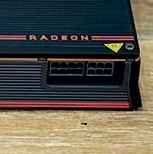AMD Radeon RX 5700 XT.


AMD’s Navi architecture has seemed as distant as its namesake for the longest time, but the wait is over at last. The company’s Radeon RX 5700 XT and 5700 turn a fresh page for AMD on the GPU front, ditching the longstanding Graphics Core Next (GCN) architecture in favor of a brand new design called RDNA.
RDNA is supposed to be more efficient and do more work per clock cycle, and be overall better suited for gaming workloads.
According to AMD, RDNA (or Radeon DNA) is the start of a serious effort to compete at the highest echelons of the graphics card market. However, when AMD first announced its new Radeon cards ahead of E3 this year, it was obvious that the company was framing the Radeon RX 5700 XT and 5700 as the start of its return to the high-end. In other words, AMD wants to get there, but it still has some way to go, which should give you an idea of where the new Navi cards stand.
The Radeon RX 5700 XT features GDDR6 memory and PCIe 4.0 support, making it the only consumer graphics cards at the moment to support the latest PCIe standard, along with the Radeon RX 5700. PCIe 4.0 offers twice the interconnect bandwidth of PCIe 3.0, or up to 16GT/s per lane, but we’re not yet at the point where single GPU configurations can really benefit from that.
The Radeon RX 5700 XT has a sleek, grooved chassis that kind of evokes some sort of futuristic body suit. It’s a huge step up from the Radeon VII, but it still doesn’t feel quite as good in hand as NVIDIA’s all-aluminum Founders Edition beauties. Then there’s that funny quirk in the side of the Radeon RX 5700 XT. At first it looks like an optical illusion, brought about by some clever kink in the grooved lines running along the card’s side. But it’s no mirage, and there’s an actual dent in the side, adding a further bit of intrigue to the card’s design.
The card is cooled by a blower fan, which means it’ll be pretty happy in small form factor cases since it dumps air out the back. In terms of power connectors, it has one 8-pin and one 6-pin connector, and a 7-phase power delivery subsystem for overclocking.
AMD is also introducing a new specification called Game clock. It’s exactly what it sounds like, and is intended as an indicator of the typical boost frequency you can expect from your average game. AMD wanted gamers to be crystal clear about what they would be getting from these cards, so the Game clock helps set expectations for what frequencies you should be getting while gaming. That said, AMD says you should still see clock speeds in excess of the Game clock pretty frequently.
The Game clock is also probably best compared with NVIDIA’s boost clock, where both refer to sustained speeds achievable in game. On the other hand, AMD’s boost clock is better thought of as something like a burst clock, which can be achieved during spikes in the graphics processing workload.
While AMD seemed to originally be setting up the Radeon RX 5700 XT for a comparison with the GeForce RTX 2070, that’s completely changed now with its price drop just a day ahead of launch. At virtually the same price as the NVIDIA GeForce RTX 2060 Super, it is also consistently faster, which makes for some seriously stiff competition.
On average, the Radeon RX 5700 XT was between 10 and 15 percent faster than the GeForce RTX 2060 Super.
However, it’s worth mentioning that NVIDIA still has the upper-hand when it comes to real-time ray-tracing. At the moment, that isn’t a super big deal since not many titles use it, but E3 saw a slate of AAA games announce support for the feature, including hotly anticipated titles like Cyberpunk 2077, Watchdogs: Legion, Call of Duty: Modern Warfare, and Atomic Heart. When 2020 rolls around, it’s possible that the Radeon RX 5700 XT’s lack of ray tracing acceleration will feel slightly more glaring.

CONCLUSION



























